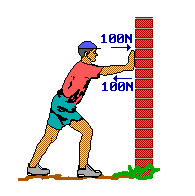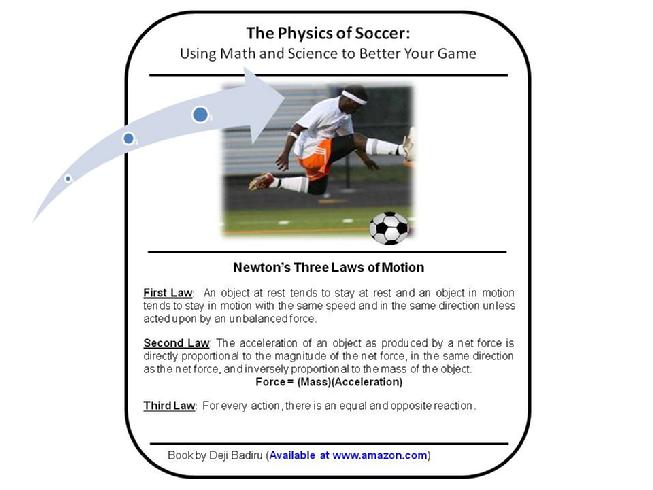Newton’s Third Law of Motion: Difference between revisions
| Line 29: | Line 29: | ||
===Elementary Example=== | ===Elementary Example=== | ||
Let’s do an experiment in which two carts, cart 1 and cart 2, collide with one another on a horizontal track, How does the momentum of each cart change? What happens to the momentum of the two-cart system? The upward normal force applied by the track on each cart is balanced by the downward force of gravity, so the '''net force experienced by each cart | |||
during the collision is that applied by the other cart.''' | |||
The collision changes the momentum of cart 1 from p1i to p1f = p1i + deltap1. | |||
Similarly, the collision changes the momentum of cart 2 from p2i to p2f = p2i + deltap2. | |||
The total momentum of the system beforehand is p1i + p2i. | |||
The total momentum of the system afterwards is p1f + p2f = p1i + deltap1 + p2i + deltap2. | |||
Consider deltap1, the change in momentum experienced by cart 1 in the collision. This | |||
change in momentum comes from the force applied to cart 1 by cart 2 during the collision. | |||
Similarly, deltap2 , cart 2’s change in momentum, comes from the force applied to cart 2 by cart 1 | |||
during the collision. Newton’s third law tells us that, no matter what, the force applied to cart 1 by | |||
cart 2 is equal and opposite to that applied to cart 2 by cart 1. Keeping in mind that the change in | |||
momentum is directly proportional to the net force, and that we’re talking about vectors, this | |||
means: | |||
deltap2 = -deltap1 | |||
Substituting this result into our expression for the total momentum of the system after the | |||
collision shows that momentum is conserved (momentum remains constant): | |||
p1f + p2f = p1i + p2i | |||
===Intermediate Example=== | ===Intermediate Example=== | ||
Revision as of 17:15, 11 April 2016
Claimed by Arohi Bhakhri
In 1686, Sir Issac Newton presented his three laws of motion in the "Principia Mathematica Philosophiae Naturalis." Newton's three laws of motion are integral to understanding why forces have the effect they do upon other bodies. Forces are products of interactions between bodies and can be defined as a interaction that has some type of effect on the motion of an object when unopposed. Forces can result by a number of contact interactions (frictional, normal, tension, applied) or just interactions between some radius (gravitational, electrical, magnetic forces). Newton's Third Law of Motion states that when there is an interaction between two objects, they are both exerting forces upon each other. A simple example would be if you were sitting down on a bench--your body exerts the same amount of force on the bencth that the bench exerts on your body, just in an opposite direction. These two forces are examples of action-reaction pairs, which is what Newton's Third Law is entirely based around. Formally stated, Newton's third law is: For every action, there is an equal and opposite reaction.
The Main Idea
As stated above, Newton's Third Law states that if object A exerts a force on object B, then object B also exerts an equal and opposite force on object A.
The third law means that all forces are interactions between different bodies, and thus that there is no such thing as a unidirectional force or a force that acts on only one body. This law is sometimes referred to as the action-reaction law, with FA called the "action" and FB the "reaction". The action and the reaction are simultaneous, and it does not matter which is called the action and which is called reaction; both forces are part of a single interaction, and neither force exists without the other.
Visualize Newton's Third Law: Video
A Mathematical Model
Using the system of A and B, we can say that the force of A on B is equal and opposite to that of B on A.
F(AB) = −F(BA)
A Computational Model
How do we visualize or predict using this topic. Consider embedding some vpython code here Teach hands-on with GlowScript
Examples
Elementary Example
Let’s do an experiment in which two carts, cart 1 and cart 2, collide with one another on a horizontal track, How does the momentum of each cart change? What happens to the momentum of the two-cart system? The upward normal force applied by the track on each cart is balanced by the downward force of gravity, so the net force experienced by each cart during the collision is that applied by the other cart.
The collision changes the momentum of cart 1 from p1i to p1f = p1i + deltap1. Similarly, the collision changes the momentum of cart 2 from p2i to p2f = p2i + deltap2. The total momentum of the system beforehand is p1i + p2i. The total momentum of the system afterwards is p1f + p2f = p1i + deltap1 + p2i + deltap2.
Consider deltap1, the change in momentum experienced by cart 1 in the collision. This change in momentum comes from the force applied to cart 1 by cart 2 during the collision. Similarly, deltap2 , cart 2’s change in momentum, comes from the force applied to cart 2 by cart 1 during the collision. Newton’s third law tells us that, no matter what, the force applied to cart 1 by cart 2 is equal and opposite to that applied to cart 2 by cart 1. Keeping in mind that the change in momentum is directly proportional to the net force, and that we’re talking about vectors, this means:
deltap2 = -deltap1
Substituting this result into our expression for the total momentum of the system after the collision shows that momentum is conserved (momentum remains constant):
p1f + p2f = p1i + p2i
Intermediate Example
Advanced Example
Connectedness
How is this topic connected to something that you are interested in? Newton's Third Law is integral to understanding motion and why it occurs a certain way. Having played soccer for several years, understanding why this law works the way it does helps in performance during matches. From Newton’s first law, it is known that the soccer ball’s motion could not have changed unless a force acted on it. Every time a soccer ball is kicked, this law comes into play. A force from the foot is exerted onto the ball--this force is called an action force. At the same time, the ball exerts a force on your foot as it is in contact with the ball. This force is called a reaction force. We are so massive compared to the ball that we do not realize that the ball actually pushes back on our foot as we push against it.
How is it connected to your major? Industrial and systems engineering is a branch of engineering which deals with the optimization of complex processes or systems. Industrial engineers work to eliminate waste of time, money, materials, man-hours, machine time, energy and other resources that do not generate value. According to the Institute of Industrial and Systems Engineers, they figure out how to do things better, they engineer processes and systems that improve quality and productivity. Having noted this, there is a physics behind productivity, especially in manufacturing firms where any extra force or motion can be holding back greater efficiency.
Is there an interesting industrial application?
History
In the English translation of the third edition of the Principia (Newton, 1729) Newton's own statement of the third of his three laws of motion reads "To every action there is always opposed an equal reaction; or the mutual actions of the two bodies upon each other are always equal, and directed to contrary parts" (p. 23). Newton's examples, immediately following this statement, include the forces of a finger on a stone and the stone on the finger, the forces between a horse and a stone (both of which are connected by a rope), the forces between two colliding bodies, and 'attractions' between objects - that is, forces, such as gravity, which act at a distance rather than through direct contact
See also
Are there related topics or categories in this wiki resource for the curious reader to explore? How does this topic fit into that context?
Further reading
Books, Articles or other print media on this topic
External links
Internet resources on this topic
References
This section contains the the references you used while writing this page


